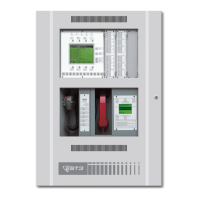Power-up and testing
EST3 Installation and Service Manual 6.13
the circuit and initiate an active fire alarm. You should
measure 20 to 25 volts between TB1-3 (+) and TB1-4 (-).
Press the panel Reset switch, and wait for the system to
reset. Verify receipt of the alarm at the municipal receiving
station.
Note: If you activate the municipal box, it will indicate
Trouble until rewound.
4b. Single Reverse Polarity Circuit (Old Style) configuration:
Verify that 20 to 25 volts appears between TB1-5 (+) and
TB1-6 (-), paying attention to polarity. Create a Trouble
condition on the panel. Verify that 0 volts appears between
TB1-5 (+) and TB1-6 (-). Verify that the module’s Trouble
relay activates, the appropriate Trouble message appears in
the Trouble message queue, and that the receiving station
receives the Trouble indication. Open the circuit wired
between TB1-5 and TB1-6. Verify that the receiving station
receives the Trouble indication.
Initiate an active fire alarm. You should measure 20 to 25
volts between TB1-5 (-) and TB1-6 (+), paying attention to
the polarity change. Verify receipt of the alarm at the
municipal receiving station.
4c. Three Reverse Polarity Circuit (New Style) configuration:
Verify that 20 to 25 volts appears between TB1-5 (+) &
TB1-6 (-), between TB1-7 (+) & TB1-8 (-), between TB1-9
(+) & TB1-10 (-), paying attention to polarity. Create a
Trouble condition on the panel. Verify that 20 to 25 volts
appears between TB1-8 (+) and TB1-8 (-). Verify that the
module’s Trouble relay activates, the appropriate Trouble
message appears in the Trouble message queue, and that the
receiving station receives the Trouble indication. Open the
circuit wired between TB1-5 and TB1-6. Verify that the
receiving station receives a circuit fault indication. Open the
circuit wired between TB1-7 and TB1-8. Verify that the
receiving station receives a circuit fault indication. Open the
circuit wired between TB1-9 and TB1-10. Verify that the
module’s Trouble relay activates and the appropriate Trouble
message appears in the Trouble message queue, and that the
receiving station receives a circuit fault indication.
Initiate an active fire alarm. You should measure 20 to 25
volts between TB1-5 (-) and TB1-6 (+), paying attention to
the polarity change. Verify receipt of the alarm at the
municipal receiving station.
Initiate an active Supervisory condition. You should measure
20 to 25 volts between TB1-9 (-) and TB1-10 (+), paying
attention to the polarity change. Verify receipt of the
Supervisory condition at the municipal receiving station.

